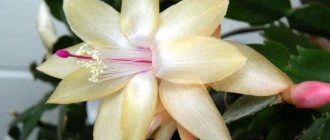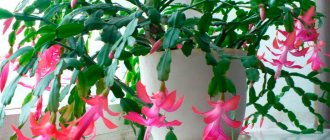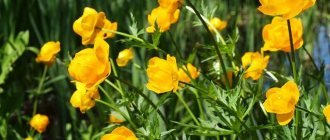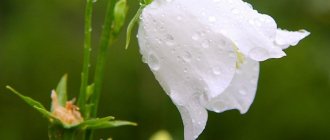Do you believe in omens? Probably only a few will shake their heads negatively. But almost every person has a story or two about how in life he was faced with an inexplicable relationship between two events that seemed to be completely unrelated. Lovers of everything mystical are ready to see omens of fate at every step, even in the most ordinary things.
A whole series of signs and superstitions are associated with an ordinary indoor flower - the Decembrist. There are a wide variety of rumors about him, he is called the “harbinger of death”, “mozhegon”, he is endowed with a wide variety of mystical properties. This article will try to understand all these signs and their reliability.
Magical properties of the plant
The Decembrist or “Decembrist” (as some older people call him) is credited with protective properties, recommending placing a flower pot near the entrance. Despite the advice, you need to remember that the flower will protect the family, home and well-being, being in any favorable place, not just on the window next to the door.
Another property of the plant is to absorb negative energy and replace it with positive energy. A strong increase in green mass and abundant flowering at the wrong time helps to understand that a flower works this way.
Important! When it comes to magic, opinions sometimes differ greatly depending on which tradition one belongs to.
Signs and superstitions about the Decembrist
Signs and superstitions for the home associated with the Decembrist indicate an ambiguous attitude towards the plant. There are few bad beliefs, folk wisdom does not really support such judgments, but there are people who believe precisely in the negative meaning of the Decembrist.
Bad omens and superstitions:
- The flower will survive from the house of all men.
- A girl in a house with such a plant will never get married.
- If the Decembrist died, one of the relatives will soon die.
- Planting a flower at home means losses and grief in the family.
Good signs:
- Flowering on time, that is, in December, means peace and harmony in the house, no matter how many people live there.
- In November, the opening of the buds indicates an upcoming pleasant acquaintance.
- December flowering promises creative people the discovery of new opportunities.
- A plant lushly covered with fragrant flowers indicates that the positive emotions of the inhabitants of the house are stronger than all adversity. Even if a single woman has Decembrist, abundant flowering indicates that she is doing well and is more than happy.
- Nectar dripped from the inflorescences - a pleasant surprise lies ahead.
- The Decembrist scent fills the whole room - a sign that promises good news soon.
- The flower unexpectedly attracted the attention of a pet - someone wants to make acquaintance with the owner of the plant.
Some older people talk about this sign: Decembrist or epiphyllum bloomed in the middle of summer and attracted bees to the window - a cheerful meeting of all relatives is ahead. There is no reasonable explanation for why two such different plants are included in the sign, but for supporters of this belief it comes true. It is noteworthy that the Decembrist almost never blooms in the summer, and the epiphyllum is capricious and will not bloom without ideal conditions, which serves as a reason for jokes that the whole family is not going to do any good.
Important! Folk signs change over time, so it is not surprising that different beliefs prevail in different eras.
Is it possible to keep Schlumbergera at home?
If the owners of the house are impressionable people who believe in all signs, then the Decembrist is not the best option for their collection of home flowers, since there is a high probability that instead of positive emotions arising from contemplating the beauty of flowers, they will be constantly in a state of internal tension, expecting negative predictions.
For everyone else, zygocactus will be an ideal green friend : it is unpretentious and decorative. The plant will bring coziness and comfort to your home environment and add a joyful mood on the eve of the winter holidays.
This plant is not poisonous, and you can even place it in children’s rooms: with its energy it will contribute to the “correct” upbringing of the baby.
Like any plant, it will participate in purifying the air of toxic substances, while releasing oxygen.
Schlumbergera is said to have a positive effect on authoritarian family members; on those who are unfriendly towards others and guests. The flower will soften their ardent disposition and harsh character.
When Decembrist blooms at home: signs
Except for those cases when good flowering on time and at the wrong time is explained by high-quality care and ideal living conditions, signs generally indicate positive changes. There are also negative superstitions. But beliefs are a specific phenomenon; usually, for those who look for the negative in everything, negative omens come true.
Signs if the Decembrist bloomed in October
According to the sign, the Decembrist blooms in October, indicating an imminent profit and an addition to the family. According to another belief, zygocactus blooms this month to receive good news. There are no superstitions that promise trouble regarding October.
Signs if the Decembrist bloomed a second time in the spring
There is a superstition that such an event foreshadows losses, unhappiness in the family, problems at work and indicates that nothing good is foreseen in the future. However, there are other beliefs:
- the second flowering in the spring, before the snow melts, indicates the imminent conception of a child;
- the appearance of an inflorescence in May means a cool summer;
- the plant bloomed in April - summer vacation will be spent in pleasant company.
Rumors that the second flowering will certainly bring trouble to the house are greatly exaggerated; popular experience casts doubt on such superstitions.
Actions after flowering
When the flowering period comes to an end, then, like all other plants, the inflorescences begin to dry out and fall off - this is a natural process. The frequency of watering during the Decembrist flowering period should be reduced .
After flowering has finished, Schlumbergera should have access to fresh and cool air. There comes a time when the botanist needs to remove the upper segment of the stem and apply flower food. Removing the top of the stem helps the plant become fuller.
After flowering, the Decembrist is watered and sprayed with only warm boiled water from a spray bottle.
Who can I give a flower to?
According to signs, the Decembrist flower can be given to young families who are just starting to live together. In addition, a beautiful plant is presented as a gift:
- people of creative professions;
- children or teenagers;
- elderly women upon retirement;
- recently moved people.
Due to the fact that bad omens about the Decembrist are considered nothing more than empty superstitions, it is even given as a wedding gift, especially varieties with white flowers.
Important! The only case when it is forbidden to give a flower is when someone in the house is seriously ill.
The plant may die trying to take away all the negativity, and if it fails to cope with the task and everything ends sadly for the person, the Decembrist will still be to blame. This is probably the reason for some superstitions.
Where is the best place to put the plant?
Feng Shui does not give recommendations on the best place for a Decembrist, esotericists also do not advise anything specific, but there are some general tips:
- a bright window is the best place, but it should not be too hot;
- It is advisable to place the Decembrist in one permanent place and not turn different sides towards the light;
- It is better not to place a flower in the married bedroom, but near the workplace or in the bedroom of a single person, the plant will be beneficial;
- a good place is on the window closest to the entrance;
- In a nursery, the Decembrist is also appropriate - it stimulates the child to develop creatively.
But wherever the flower stands, you should make sure that it is not chewed by pets. The pets will not benefit from this, but the plant will suffer. There are no special superstitions associated with the location of the Decembrist.
How many times a year does this happen?
How often can flowering be observed? In one calendar year, the Christmas tree can bloom only once. In 12 months it goes through four stages of its growth and development, which indicates a long preparation for flowering.
Periods of development of Schlumbergera:
- Vegetation.
- Rest (at this time, preparation for the release of buds and their formation occurs).
- Bloom.
- Dormancy (completion of flowering and restoration).
Schlumbergera goes through several periods in its development throughout the year, which must be taken into account to achieve success in growing this plant.
Let's look at each period in detail:
- The “Vegetation” period is March – September, the plant gains strength, grows and increases the supply of substances necessary and useful for it, and produces additional segments. At such times, the best place for its growth will be an open room, close to growth in a natural environment - this could be a terrace or balcony.
During this period, the plant should be sprayed with warm water and watered as the soil dries. The most suitable temperature for Schlumbergera during the growing season will be +21-24 Celsius.
The period of "Quiet" is September - October. Flower buds begin to form. Watering during this period should be reduced and cooler and fresher air should be provided, around 11-19C. Slightly wrinkled leaves will serve as a signal for watering. It is better to replace water with weak tea leaves.
If no approaching frosts are observed until November, then the Schlumbergera does not need to be moved from an open place indoors. The plant is not afraid of temporary, short-term drops in temperature to 4-6C. When watering, monitor the amount of liquid entering the plant! Decembrist is characterized by rotting of the root system. Overwatering can lead to the death of the plant. The “Blooming” period begins in November and ends in January or February. At this time of year, the flower should be placed indoors, in the place where it was previously, before moving it outside. During the flowering period, it is advisable to apply potassium-phosphorus fertilizers and water with an infusion of water on eggshells, as well as fertilize with a solution of calcium nitrate.
Decembrist blooms at an air temperature of 16-21 Celsius. Throughout the entire flowering period, it is recommended to avoid contact with the plant, i.e. do not move it, move it or wash it. The period of “Rest” or recovery is from February to March. After the Decembrist flower has faded, the time has come for its formation. You should unscrew the tops of the segments on the shoots, thereby stimulating the process of branching and making the bush thicker.
How to avoid the consequences predicted in signs
Despite the fact that few people believe in bad omens associated with the plant, there are at least three ways to avoid negativity.
- If the flower has not died, it is advised to “cajole” it, systematize its care, replace the pot, and move it to a more favorable place.
- Plants of the opposite meaning are planted - the more, the better.
- If the Decembrist has already died, they try to remove the dead plant from the house as soon as possible and cleanse the home of negative energy.
But the simplest method is to find a good interpretation and believe in it more than in all superstitions and bad omens.
Important! Sometimes negative signs are not associated with mysticism and superstition. Superstitions can be caused by improper care and unsuitable conditions.
The main reasons for the lack of flowering
- Lack of fertilizers in the soil or one of the nutritional components.
- Lack of natural light.
- Insufficient volume of irrigation water in summer.
- Keeping the plant in the same container for more than five years. Immediate replanting of the indoor flower is required.
- Incorrectly selected flower container. A pot that is too large allows the root part to develop excessively, which affects the entire plant as a whole.
Decembrist is an indoor perennial that can bloom every year for two or more decades.
Reviews about signs and superstitions about the Decembrist flower
There is a lot of talk about signs and superstitions regarding the Decembrist in the house on various forums. Most of the discussion concerns whether to believe bad omens. As a result, there are three different types of opinions: you should believe only in good things, you need to focus on negative beliefs, it is better to forget about superstitions altogether.
Albina, 48 years old, Tambov
From my own experience I will say that the Decembrist brings only good. My mother gave me a flower for a wedding, I don’t know what the variety is called, with white inflorescences. More than twenty years have passed, and it is thriving. And my family too. I have a favorite job, my husband changed several jobs, but in the end he found “the one.” Children generally experience success, with the exception of minor failures, but no one is protected from them. I don’t see any reason for negativity towards the Decembrist.
Ekaterina, 39 years old, Moscow
I don’t believe in omens, but the Decembrist brought home only misfortune. First, my parents divorced in their old age, then my husband almost died, and as a result the bush dried up and the dog died. Thank God, only a dog! I will definitely not have such a flower again. Or here's a friend. A colleague gave her a flowering bush, and the next day problems began. I don’t think she meant any harm, but at the same time her friend ended up in the hospital and was on the verge of divorce and dismissal. Fortunately, when I returned home, I took it to work. The troubles are over, but he is never going to bring the Decembrist home again.
Elvira, 27 years old, Birobidzhan
I see no reason to believe in any signs. How many flowers have been at home - there have never been any changes. Neither for the better nor for the worse. Yes, a healthy, blooming green plant lifts your spirits, but nothing more. And linking his death with failures is simply stupid. It spoils the mood, but that's all. I remember when I was little, how my mother grew three of these flowers, she affectionately called them “Decembrists”. But whatever happens, it certainly has nothing to do with the plants.











